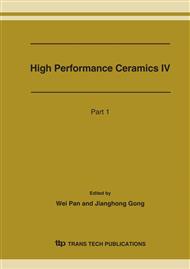p.58
p.62
p.66
p.69
p.73
p.76
p.79
p.83
p.87
Reliability of Ba(Zr0.1Ti0.9)O3 Ferroelectric Thin Films under Various Frequencies for Nonvolatile Memory Application
Abstract:
In this study, ferroelectric thin films of Ba(Zr0.1Ti0.9)O3 were successfully deposited on Pt/Ti/SiO2/Si substrate under the optimal rf magnetron sputtering parameters, and their electrical and ferroelectric characteristics were investigated. The MFMIS structure of Al/Ba(Zr0.1Ti0.9)O3/ Pt/Ti/SiO2/Si was proposed in order to be applied as NDRO FRAM applications. From the experimental results obtained, the dielectric constant and the leakage current density of BZT films were about 200 and 1×10-9A/cm2, respectively, under the electrical field of 1 MV/cm. Besides, the saturation polarization and coercive field of Ba(Zr0.1Ti0.9)O3 films were found to be 4 μC/cm2 and 25 kV/cm, respectively, as the frequency of 103 Hz was applied. The variations of saturation polarization and coercive filed of films under various frequencies ranging form 102 to 106 Hz were also discussed.
Info:
Periodical:
Pages:
73-75
Citation:
Online since:
April 2007
Price:
Сopyright:
© 2007 Trans Tech Publications Ltd. All Rights Reserved
Share:
Citation:


